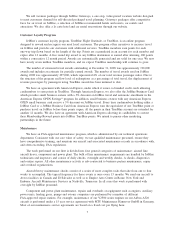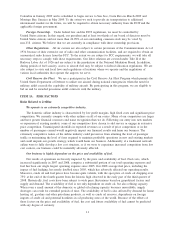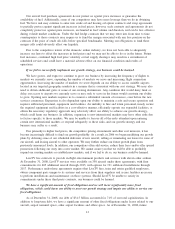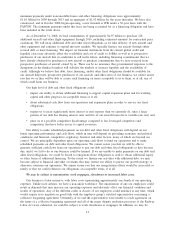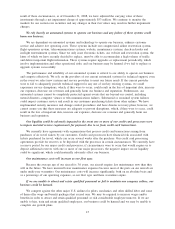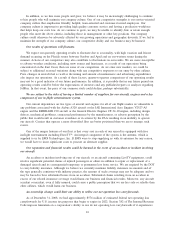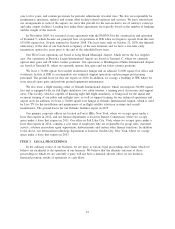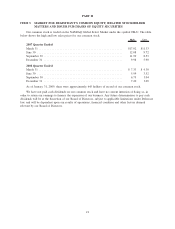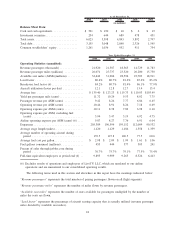JetBlue Airlines 2008 Annual Report Download - page 23
Download and view the complete annual report
Please find page 23 of the 2008 JetBlue Airlines annual report below. You can navigate through the pages in the report by either clicking on the pages listed below, or by using the keyword search tool below to find specific information within the annual report.subject to disruptions by organized labor groups protesting our non-union status. Any of these events would be
disruptive to our operations and could harm our business.
We rely on maintaining a high daily aircraft utilization rate to keep our costs low, which makes us
especially vulnerable to delays.
We maintain a high daily aircraft utilization rate, which is the amount of time that our aircraft spend in
the air carrying passengers. High daily aircraft utilization allows us to generate more revenue from our aircraft
and is achieved in part by reducing turnaround times at airports so we can fly more hours on average in a day.
Aircraft utilization is reduced by delays and cancellations from various factors, many of which are beyond our
control, including adverse weather conditions, security requirements, air traffic congestion and unscheduled
maintenance. The majority of our operations are concentrated in the Northeast and Florida, which are
particularly vulnerable to weather and congestion delays. Reduced aircraft utilization may limit our ability to
achieve and maintain profitability as well as lead to customer dissatisfaction.
Our business is highly dependent on the New York metropolitan market and increases in competition
or congestion or a reduction in demand for air travel in this market, or our inability to operate reliably out
of our new terminal at JFK, or governmental reduction of our operating capacity at JFK, would harm our
business.
We are highly dependent on the New York metropolitan market where we maintain a large presence with
approximately 62% of our daily flights having JFK, LaGuardia, Newark, Westchester County Airport or
Newburgh’s Stewart International Airport as either their origin or destination. We have experienced an increase
in flight delays and cancellations at JFK due to airport congestion, which has adversely affected our operating
performance and results of operations. Our business could be further harmed by an increase in the amount of
direct competition we face in the New York metropolitan market or by continued or increased congestion,
delays or cancellations. Our business would also be harmed by any circumstances causing a reduction in
demand for air transportation in the New York metropolitan area, such as adverse changes in local economic
conditions, negative public perception of New York City, terrorist attacks or significant price increases linked
to increases in airport access costs and fees imposed on passengers.
Any non-performance of the building’s critical systems at Terminal 5, such as baggage sortation,
information technology, or customer notification systems, could negatively affect our operations and harm our
business.
On October 10, 2008, the DOT issued its final Congestion Management Rule for JFK and Newark
International Airport imposing caps on operations and slot authority requirements and confiscation measures
through an auction process. We are participating in the litigation challenging the rule, which if ultimately
successful and the auctions are permitted to proceed, we would likely lose a portion of our operating capacity
at JFK, which would negatively impact our ability to fully utilize our new terminal and may result in
increased competition, which could harm our business.
A substantial portion of our long-term marketable securities are highly rated auction rate securities,
and failures in these auctions have and may continue to adversely impact our liquidity and results of
operations.
A substantial percentage of our marketable securities portfolio is invested in highly rated auction rate
securities. Auction rate securities are securities that are structured to allow for short-term interest rate resets;
however contractual maturities are often well in excess of ten years. At the end of each reset period, investors
can sell or continue to hold the securities at par. Beginning in February 2008, due to then-prevailing
conditions in the credit markets, the auction process for all of our auction rate securities failed, which resulted
in the interest rates on these investments resetting to predetermined rates that were, in some instances, lower
than current market rates. We will not be able to liquidate our investments in these types of securities until a
future auction is successful, the issuer redeems the securities, a buyer is found outside the auction process, the
securities mature, or there is a default that requires immediate repayment by the issuer. Continued failure of
auctions have adversely impacted the liquidity and overall value of our investments, and if one or more of the
issuers of the auction rate securities in our portfolio cannot successfully close future auctions or their credit
ratings deteriorate, this could continue to have a material adverse effect on our results of operations. As a
14





